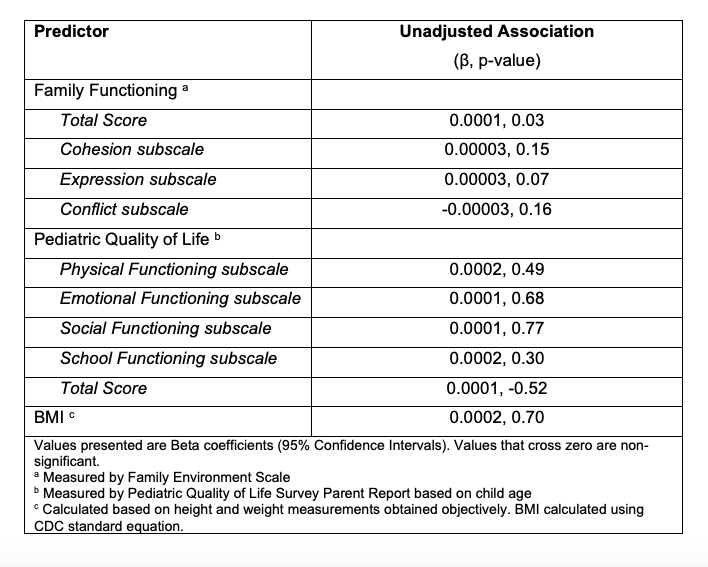Obesity
Category: Abstract Submission
Obesity II
517 - Association between family functioning and pediatric quality of life with fruit and vegetable intake and BMI in children from low-income households
Saturday, April 23, 2022
3:30 PM - 6:00 PM US MT
Poster Number: 517
Publication Number: 517.239
Publication Number: 517.239
Suranjana Dey, Nationwide Children's Hospital and The Ohio State Univeristy, Columbus, OH, United States; Shivika Udaipuria, Nationwide Children's Hospital, Columbus, OH, United States; Colleen Spees, The Ohio State University Medical Center, Columbus, OH, United States; Casey W. Hoy, The Ohio State University, Wooster, OH, United States; Amrik S. Khalsa, Nationwide Children's Hospital, Columbus, OH, United States
- SD
Suranjana Dey, MD, MPH (she/her/hers)
Internal Medicine-Pediatric Physician Resident, PGY2
Nationwide Children's Hospital and The Ohio State Univeristy
Galloway, Ohio, United States
Presenting Author(s)
Background: Increased fruit and vegetable (F/V) intake in children is associated with positive home environments (e.g., high family cohesion) and lower BMI in children. However, the relationship between F/V intake and family functioning, pediatric quality of life, and BMI in families from low-income households has not been examined.
Objective: To determine the relationship between F/V intake along with child BMI with family functioning and pediatric quality of life in children 2-8 years from low-income households at the start of a community garden intervention.
Design/Methods: We analyzed data from a community-based garden intervention (2018-2021) that provided tools and resources for families from low-income households to grow fruits and vegetables. Families with a child age 2-8 years old were invited to collect physical, mental, and psychosocial health measures. Anthropometrics were measured by trained research personnel, family functioning was measured via Family Environment Scale (FES), pediatric quality of life was measured via PedsQL survey, and F/V intake was measured via skin carotenoids through resonance spectroscopy. Bivariate regression analysis was used to determine the associations between F/V intake, family functioning, pediatric quality of life, and BMI using SAS 9.4.
Results: Data were analyzed from 85 children (47% female) with an average age of 5.7 years (SD 2.2) across 6 different community sites, with a median household income of $34,080. Skin carotenoid scores were associated with higher FES scores (=0.0001, p=0.03) but not PedsQL or BMI. Child BMI was positively correlated with the Conflict subscale from the FES (=7.31, p < 0.01). However, child BMI was negatively correlated with overall FES scores (=-2.86, p=0.03), PedsQL (B=-0.79, p=0.01), and the Emotional and Social Functioning subscales of PedsQL (= -0.7, p-=0.01; =-0.59, p < 0.01 respectively).Conclusion(s): F/V intake is positively associated with family functioning but not pediatric quality of life while child BMI is positively correlated with poor family functioning and decreased pediatric quality of life. Future analysis will examine how participation in gardening changes childhood fruit and vegetable intake, family functioning, and pediatric quality of life in one season.
S_Dey_CV_20222021_Dey_Suranjana_CV_Med_Ped_OSU_PDF.pdf
Table 2: Relationship between Fruit and Vegetable Intake and Family Functioning, Pediatric Quality of Life, and BMI
Objective: To determine the relationship between F/V intake along with child BMI with family functioning and pediatric quality of life in children 2-8 years from low-income households at the start of a community garden intervention.
Design/Methods: We analyzed data from a community-based garden intervention (2018-2021) that provided tools and resources for families from low-income households to grow fruits and vegetables. Families with a child age 2-8 years old were invited to collect physical, mental, and psychosocial health measures. Anthropometrics were measured by trained research personnel, family functioning was measured via Family Environment Scale (FES), pediatric quality of life was measured via PedsQL survey, and F/V intake was measured via skin carotenoids through resonance spectroscopy. Bivariate regression analysis was used to determine the associations between F/V intake, family functioning, pediatric quality of life, and BMI using SAS 9.4.
Results: Data were analyzed from 85 children (47% female) with an average age of 5.7 years (SD 2.2) across 6 different community sites, with a median household income of $34,080. Skin carotenoid scores were associated with higher FES scores (=0.0001, p=0.03) but not PedsQL or BMI. Child BMI was positively correlated with the Conflict subscale from the FES (=7.31, p < 0.01). However, child BMI was negatively correlated with overall FES scores (=-2.86, p=0.03), PedsQL (B=-0.79, p=0.01), and the Emotional and Social Functioning subscales of PedsQL (= -0.7, p-=0.01; =-0.59, p < 0.01 respectively).Conclusion(s): F/V intake is positively associated with family functioning but not pediatric quality of life while child BMI is positively correlated with poor family functioning and decreased pediatric quality of life. Future analysis will examine how participation in gardening changes childhood fruit and vegetable intake, family functioning, and pediatric quality of life in one season.
S_Dey_CV_20222021_Dey_Suranjana_CV_Med_Ped_OSU_PDF.pdf
Table 2: Relationship between Fruit and Vegetable Intake and Family Functioning, Pediatric Quality of Life, and BMI

